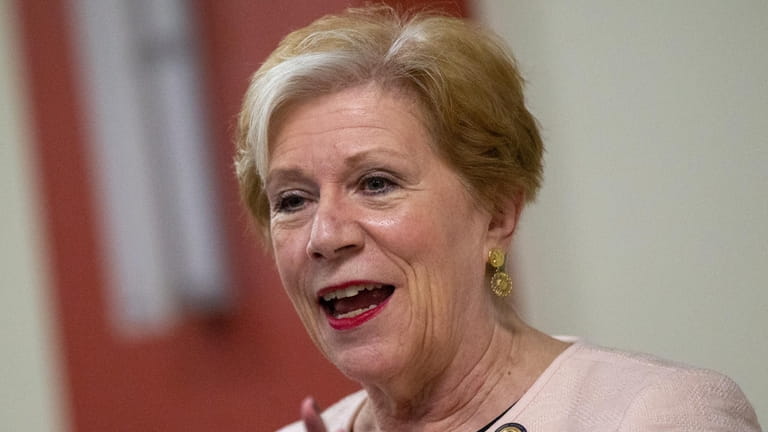New York State minimum wage will rise with inflation index starting in 2027

After climbing to $17 over the next three years, Long Island's minimum wage will increase automatically to keep pace with inflation.
The historic change, tucked into the state budget adopted in May, is meant to help low-wage workers across New York State cope with the rising costs of groceries, gasoline and other basic necessities. But the change also will boost the expenses of employers, some of whom may not be able to recoup the higher payroll costs by raising prices or trimming their workforce.
On Long Island, the minimum wage has been $15 per hour since the end of 2021 — higher than in all but two states and the District of Columbia, according to a Newsday analysis. The rate will go to $16 on Jan. 1 and increase by 50 cents in both 2025 and 2026 under the provision adopted with the budget this spring. The rate will hit $17 per hour on Jan. 1, 2026.
HOW IT WORKS
Beginning in 2027, New York State's minimum wage will increase based on changes in the Consumer Price Index for Urban Wage Earners and Clerical Workers in the Northeast (CPI-W). Here's an example of how it would work:
- The minimum wage will be $17 per hour in downstate as of Jan. 1, 2026.
- Late that year, the state Department of Labor will look at the average increase in the CPI-W over the past three years. That average will determine the increase in the minimum wage.
- If the CPI-W increased an average of 2.6%, for example, the minimum wage will rise 2.6%, or 44 cents, to $17.44 on Jan. 1, 2027.
Each year after that, the minimum wage will be adjusted based on an inflation index that tracks spending by working families in the Northeast: the Consumer Price Index for Urban Wage Earners and Clerical Workers. The only factors that would prevent the minimum from rising each year are high unemployment, significant job losses or a big drop in consumer prices. The rate would never decrease, state officials said.
Tying increases in the minimum wage to an inflation index is historic for New York, but 18 other states and Washington, D.C., already do so. Washington state was the first to endorse “indexing” its hourly minimum in 1998, the Newsday analysis shows.
“This will mean a lot to both workers and employers,” said Roberta Reardon, New York’s labor commissioner since 2015.
“Workers will know that if inflation goes up, so do their wages," she said. "This will mean a more stable workforce for employers because there will be less incentive for employees to move across the street to chase an extra dollar [in hourly pay]."
Reardon and others said minimum-wage earners, who are more likely to be women and members of minority groups, will spend their additional pay on necessities for themselves and family members as well as on restaurant meals, entertainment and other discretionary purchases.

State Labor Commissioner Roberta Reardon said the change will help workers and mean a more stable workforce for employers. Credit: Howard Schnapp
“If a low-wage worker gets an increase in their paycheck, it surely doesn’t go to an offshore bank account,” Reardon said in an interview. “It’s going to be spent locally and that really helps small businesses."
That assumes that the small stores haven’t shut down because they couldn’t accommodate the higher minimum wage, said opponent Ashley Ranslow, state director for the National Federation of Independent Business, which lobbies for small businesses in Albany.
This will mean a more stable workforce for employers because there will be less incentive for employees to move across the street to chase an extra dollar [in hourly pay].
— Roberta Reardon, state labor commissioner
Driving up costs
“The state is driving up the cost of doing business with mandated wage hikes in perpetuity,” she said. “Small employers are less likely to have the cash reserves or profit margins to plan for and absorb the aggressive increase in labor costs than larger corporate employers.”
Matt Cohen, CEO and president of the Long Island Association business group, agreed, saying, “Recurring increases in the minimum wage present yet another challenge to our economic competitiveness” as a region.
Employers are divided over the potential fallout from the annual pay increases.
The state is driving up the cost of doing business with mandated wage hikes in perpetuity.
— Ashley Ranslow, state director for the National Federation of Independent Business
Some said they would reduce workers’ hours, focus on selling more profitable goods or turn to automation. Others said they would raise prices, but also predicted higher sales because consumers would have more free cash.
At Kurt Weiss Greenhouses Inc. in Center Moriches, general manager Bill Zalakar said he will be forced to cut staff and reduce the number of hours worked by the remaining employees.
The company, which grows hydrangeas and bedding plants sold by large chain stores, has already instituted cost-saving measures in response to the minimum wage rising to $15, the threshold for farmworkers to be paid overtime dropping to 40 hours, and the introduction of state-mandated paid sick days.

General manager Bill Zalakar said Kurt Weiss Greenhouses Inc. in East Moriches will be forced to cut staff and reduce hours for its remaining employees. Credit: Tom Lambui
“We will cut back on the number of people and continue to reduce hours,” Zalakar said, adding that he trimmed work schedules 10% to 15% after the hourly minimum hit $15. “I want the people to have a livable wage, but I also have to be able to stay in New York State.”
He said the family-owned company still ships 1 million plants per day from Center Moriches in the spring, but more plants are being grown at its farms in Florida, New Jersey and Pennsylvania, all of which have lower minimum wages.
The company employs 250 to 275 people, with 175 to 200 holding full-time positions. The average wage is $17 to $20 per hour.
“Every time there is an increase in the minimum wage it affects all the other pay rates,” said Zalakar, who sits on the board of the New York Farm Bureau, a trade group. “I doubt that the big chain stores are going to give us a yearly increase [in the price they pay for plants] to match the minimum wage increase.”
On the other side, Dylan Skolnick, co-director of the nonprofit Cinema Arts Centre in Huntington village, said he’s disappointed that state leaders set $17 per hour as the starting point for inflation indexing instead of the $21.25 an hour proposed by some pro-labor groups.
“Fifteen dollars is too damn low, and in three years $17 probably won’t be enough because prices only go up,” he said.
The movie theater pays its 12 hourly employees who sell and collect tickets, operate the concession stands and perform other customer service duties $16, on average, and theater managers $20. The nonprofit, which was founded in 1973 by Skolnick's parents, has a total workforce of about 25 people.

Dylan Skolnick, co-director of the Cinema Arts Centre in Huntington, said the increase should have been more. Credit: Dawn McCormick
“The idea that you can employ people and then not pay them enough money to live on seems to me to be ethically wrong,” he said during a tour of three renovated auditoriums and an events space.
Asked if Cinema Arts would raise ticket prices because of the escalating minimum wage, Skolnick said, “Money is tight. But if we need to raise prices, it won't be solely because wages are going up. The cost of electricity, insurance, shipping — everything is going up.”
Public favors indexing
Public opinion overwhelmingly sides with supporters of indexing the minimum wage to inflation.
Seven in 10 New Yorkers endorsed indexing in two nationwide surveys, both conducted by the University of Maryland’s polling unit, the Program for Public Consultation. The results were the same in a February survey of 198 New Yorkers and a 2017 survey of 400 state residents.
Charles Lewitus, the program’s research analyst, said, “People are concerned that their wages aren’t keeping up with inflation, and that’s putting pressure on elected officials to take action.”
Among the 18 states and the District of Columbia that adopted indexing before New York, most did so via public referenda. Five of the states have yet to begin indexing, with both Connecticut and Missouri starting next year, according to the Newsday analysis.
The states and Washington, D.C., are divided over which inflation index to use.
Seven states have adopted some version of the index that New York chose: the Consumer Price Index for Urban Wage Earners and Clerical Workers, or CPI-W, which tracks spending by working families and is also used to determine the annual cost-of-living increase in Social Security benefits. Other places use the Employment Cost Index, Personal Consumption Expenditures Price Index or a broader version of the Consumer Price Index, the analysis shows. All of the indexes are produced by the federal government.
New York’s minimum wage — $17 downstate and $16 upstate by 2026 — will increase annually based on a three-year average of the CPI-W for the Northeast. The rate to take effect each Jan. 1 will be announced by Oct. 1 of the previous year, according to state officials.
There will be three “off-ramps” that could prevent a wage hike: a year-over-year drop below zero in the CPI-W, an increase of at least 0.5 percentage points in the state's unemployment rate, or a decrease in the number of non-farm jobs. If any one of these circumstances occurs, the minimum wage would be held steady for up to two years.
Besides New York, Maine is the only state to raise its hourly minimum based on movement in the CPI-W for the Northeast. After three years of increases, Maine's minimum is $13.80.
Impact on prices
“With wages going up every year, you’ve got to raise prices, which impacts your sales and your customers,” said Curtis F. Picard, CEO and president of the 350-member Retail Association of Maine. “You’ve got to change your business model in some way, and that’s not always going to be successful for every business.”
Indexing the minimum wage in Maine has had the most impact on restaurants and seasonal businesses because they need lots of employees. “It affects their ability to compete, and in some cases, to survive," he said.
The largest seasonal business in southern Maine, the amusement park Funtown Splashtown U.S.A., has seen its payroll grow by “hundreds of thousands of dollars” since voters approved a 2016 ballot measure, according to general manager Cory Hutchinson.
The measure increased the hourly minimum from $7.50 to $12 by 2020 and then indexed future rises to inflation. In response, the amusement park hiked ticket prices by $10, to $48 per person, before indexing was implemented. Since then, the price has gone up to $55.

Guests line up for a ride at Funtown Splashtown USA in Saco, Maine, where the general manager says minimum wage increases have forced price increases. Credit: Portland Press Herald via Getty /Portland Press Herald
Not here 'to break even'
“This has had a massive impact on us, and it’s going to be the people coming into the park that will pay for the [wage] increase,” Hutchinson said. “There’s no way that we can just eat it. We’re opening our doors to make a profit, not to break even.”
Hutchinson said Funtown’s higher ticket prices have been noticed by his Maine customers, but not those from the New York metropolitan area, Connecticut, Massachusetts, New Jersey and elsewhere. The 56-year-old park is open up to 100 days a year and needs 3,000 visitors per day to be profitable.
Funtown has 25 full-time employees and between 500 and 600 part-timers, many of them high school and college students. He said that those who are 14 to 15 years old are paid $15 per hour; 16 to 17 years old, $16.50; 18 years old, $17; and beginning lifeguards, $18 to $19.
“The voters thought that [minimum-wage] employees would have a lot more money in their pocket, so they could save a little and buy a few more things,” Hutchinson said. “But what we’ve seen in Maine is that the price of everything goes up as wages go up. Employees don’t have more money in their pocket at the end of the week.”
That circumstance has led advocates of indexing who are more than 700 miles to the west, in Ohio, to call for a suspension of indexing so that state’s minimum wage can be quickly raised from $10.10 per hour to $15. Indexing would resume after the $15 threshold is met.
Ohio began indexing after its hourly minimum reached $6.85 in 2007, and $3.25 has been added in the past 16 years.
Michael Shields, a senior researcher at Policy Matters Ohio, a progressive think tank in Cleveland, lauded New York for waiting to begin indexing until its minimum wage reaches $17 per hour and therefore is "much closer to the cost of living."
He continued, "Indexing then will prevent New York's minimum wage from devaluation. In Ohio, the indexing prevents us from losing ground but there's still a big shortfall between the cost of living and [Ohio's] minimum wage. So we need a real, not just a nominal, increase in addition to the indexing."
Shields' group championed the successful 2006 referendum that established indexing in Ohio. Since then, he said raising the hourly minimum every year hasn't led to widespread layoffs. “There’s little to no effect on the overall number of jobs,” he said.

